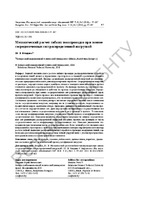| dc.contributor.author | Бладыко, Ю. В. | ru |
| dc.coverage.spatial | Минск | ru |
| dc.date.accessioned | 2018-04-06T09:20:43Z | |
| dc.date.available | 2018-04-06T09:20:43Z | |
| dc.date.issued | 2018 | |
| dc.identifier.citation | Бладыко, Ю. В. Механический расчет гибких токопроводов при замене сосредоточенных сил распределенной нагрузкой = Mechanical Calculation of Flexible Wires when the Concentrated Forces are Replaced by a Distributed Load / Ю. В. Бладыко // Энергетика. Известия высших учебных заведений и энергетических объединений СНГ. - 2018. - № 2. - С. 97-107. | ru |
| dc.identifier.uri | https://rep.bntu.by/handle/data/40068 | |
| dc.description.abstract | Задачей механического расчета гибких проводов распределительных устройств и воздушных линий является определение стрел провеса и тяжений в различных режимах климатических воздействий. Провод с равномерно распределенной нагрузкой рассматривается как однородная гибкая нить, имеющая очертание параболы. Сосредоточенные нагрузки от распорок, заградительных шаров, шлейфов, отпаек к электрическим аппаратам и других элементов заменяются распределенной по пролету. На примере пролета без натяжных гирлянд изоляторов рассматривается действие на провод сосредоточенных нагрузок, определяется погрешность при замене сосредоточенных сил равномерно распределенной вдоль пролета нагрузкой. Стрела провеса для эквивалентного провода определяется с помощью коэффициента увеличения стрелы провеса, обусловленного наличием сосредоточенных сил. Составлено уравнение состояния, которое позволяет определить тяжение после изменения числа сосредоточенных нагрузок, например после установки распорок, подвешивания заградительных шаров, крепления отпаек. Приведена зависимость максимальной стрелы провеса от числа сосредоточенных сил. Дано определение коэффициенту сосредоточенных сил как отношению суммы сосредоточенных нагрузок к весу провода в пролете. Установлена связь между коэффициентами нагрузки, увеличения стрелы провеса и коэффициентом сосредоточенных сил. Выведены формулы определения погрешности замены сосредоточенных сил равномерно распределенной нагрузкой по длине пролета как функции от числа сосредоточенных сил и коэффициента сосредоточенных сил. Показано уменьшение погрешности при увеличении числа сосредоточенных сил. Более точный расчет механических напряжений и стрел провеса возможен при применении векторно-параметрического метода расчета гибкой ошиновки распределительных устройств и проводов воздушных линий, где положена расчетная модель проводов в виде гибкой упругой нити с учетом пространственного расположения всех конструктивных элементов. | ru |
| dc.language.iso | ru | ru |
| dc.publisher | БНТУ | ru |
| dc.subject | Sag | en |
| dc.subject | Tension | en |
| dc.subject | Flexible thread | en |
| dc.subject | Chain line | en |
| dc.subject | Equation of state | en |
| dc.subject | Equivalent wire | en |
| dc.subject | Load factor | en |
| dc.subject | Стрела провеса | ru |
| dc.subject | Тяжение | ru |
| dc.subject | Гибкая нить | ru |
| dc.subject | Цепная линия | ru |
| dc.subject | Уравнение состояния | ru |
| dc.subject | Эквивалентный провод | ru |
| dc.subject | Коэффициент нагрузки | ru |
| dc.title | Механический расчет гибких токопроводов при замене сосредоточенных сил распределенной нагрузкой | ru |
| dc.title.alternative | Mechanical Calculation of Flexible Wires when the Concentrated Forces are Replaced by a Distributed Load | en |
| dc.type | Article | ru |
| dc.identifier.doi | 10.21122/1029-7448-2018-61-2-97-107 | |
| local.description.annotation | The objective of mechanical calculation of flexible wires of substations and overhead lines is to determine the sag and tension in different climatic conditions. A wire with a uniformly distributed load is considered as a homogeneous flexible thread having the form of a parabola. Concentrated loads from spacers, barrier balls, stubs, taps to electrical apparatus and other elements are replaced with the one distributed over the span. On behalf of a span without tension springs of insulators the action of concentrated loads on the wire is considered, an error is determined when replacing the concentrated forces with the one uniformly distributed along the span by the load. The sag for the equivalent wire is determined with the aid of the ratio of the increase of the sag, due to the presence of concentrated forces. An equation of state has been drawn up which makes it possible to determine the tension after changing the number of concentrated loads, e.g., after installing spacers, hanging the barrier balls, fixing the taps. The dependence of the maximum sag on the number of concentrated forces is given. The definition of the coefficient of concentrated forces as the ratio of the sum of the concentrated loads to the weight of the wire in the span is presented. A relationship between the load factors, the increase of the sag and the coefficient of concentrated forces is established. The formula has been deduced for determining the error in the replacement of concentrated forces by a uniformly distributed load along the span as a function of the number of concentrated forces and the coefficient of concentrated forces. A decrease in the error with an increase in the number of concentrated forces has been demonstrated. A more accurate calculation of mechanical tensions and sag is possible with the use of a vector-parametric method for calculating the flexible busbar of substations and air-line wires, where the design model of wires in the form of a flexible elastic thread is placed, taking into account the spatial disposition of all structural elements. | en |

